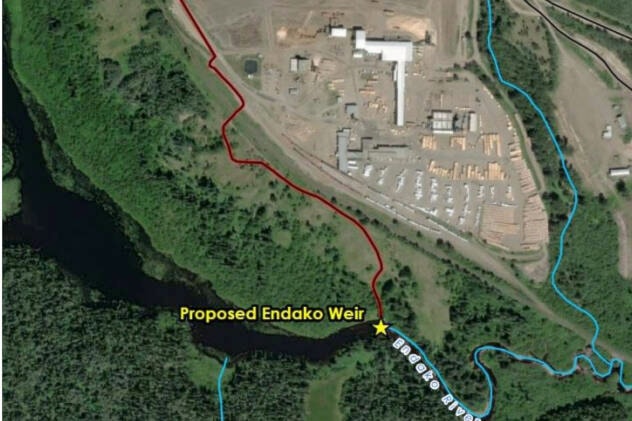In May 2021, the Upper Fraser Fisheries Conservation Alliance (UFFCA) began consultation with the Regional District of Bulkley-Nechako (RDBN) regarding the Endako Weird Project, the construction of a passive rock weir on the Endako River at the outlet of Burns Lake.
The purpose of the weir would be to slow the release of water from Burns Lake and Decker Lake during the summer, resulting in increased flows in the Endako River in the fall when chinook salmon and kokanee salmon are spawning.
After encouragement from the RDBN to evaluate potential flooding and bank erosion impacts associated with higher water levels in Burns Lake, the UFFCA completed with a shoreline and water quality risk assessment report, which was delivered to the the RDBN board of directors during a March 31 meeting.
The report outlines several recommendations should the weir be put in place. The report suggests that the RDBN will have to regularly assess sediment deposition on the lakeside and downstream sides of the proposed weir, and that they should install a stage sensor in Decker Lake so that the UFFCA can monitor water levels during weir operations.
In addition, it was recommended to monitor shoreline erosion on areas identified as having high and very high erosion hazard ratings which are outlined in the report, and to monitor the conditions of shoreline vegetation for signs of vegetation redistribution, thinning, and drowning.
Consulting engineers to assess the potential impact on highways and railways was also listed as a recommendation from the assessment.
RDBN Director of Electoral Area B Michael Riis-Christianson expressed a need to ask for more information from the UFFCA.
READ MORE: Endako Weir Project provides updates to VBL
“I definitely have concerns with the findings of this report. The only points identified as high and very high erosion potential from the weir relate to the developed waterfront areas in Burns Lake,” Riis-Christianson said to the board of directors during the meeting.
“The report mentions that the raising the water from the weir could have impacts on infrastructure like road and rail, but they didn’t actually identify what those impacts are. It also didn’t mention anything about septic systems or with the village’s sewage complex down at Richmond Loop. What they’re recommending in regards to the monitoring systems after the weir has been built, to me that seems like closing the barn door after the horse has opened. This report doesn’t really identify any ways that the issues like sediment deposition and shoreline erosion are going to be addressed,” he continued.
READ MORE: Regional economic development plan
Director of Electoral Area D Mark Parker echoed the testament, noting that more information is needed on the potential effects of the weir. “I’d like to see a bit more detail on downstream of the Endako and what the effects are when it comes to the Fraser Lake [area]. If there’s none, that’s great, and if there’s some that’s okay, but either way we need to know those potential impacts,” he said.
Ultimately, the board approved a motion to contact the province to determine the approval process for the weir moving forward, to further understand how the concerns raised will be evaluated, and how impacts will be monitored and mitigated should the weir be constructed.
Have a story tip? Email:
Eddie Huband
Multimedia Reporter
eddie.huband@ldnews.net
Like us on Facebook and follow us on Twitter.
